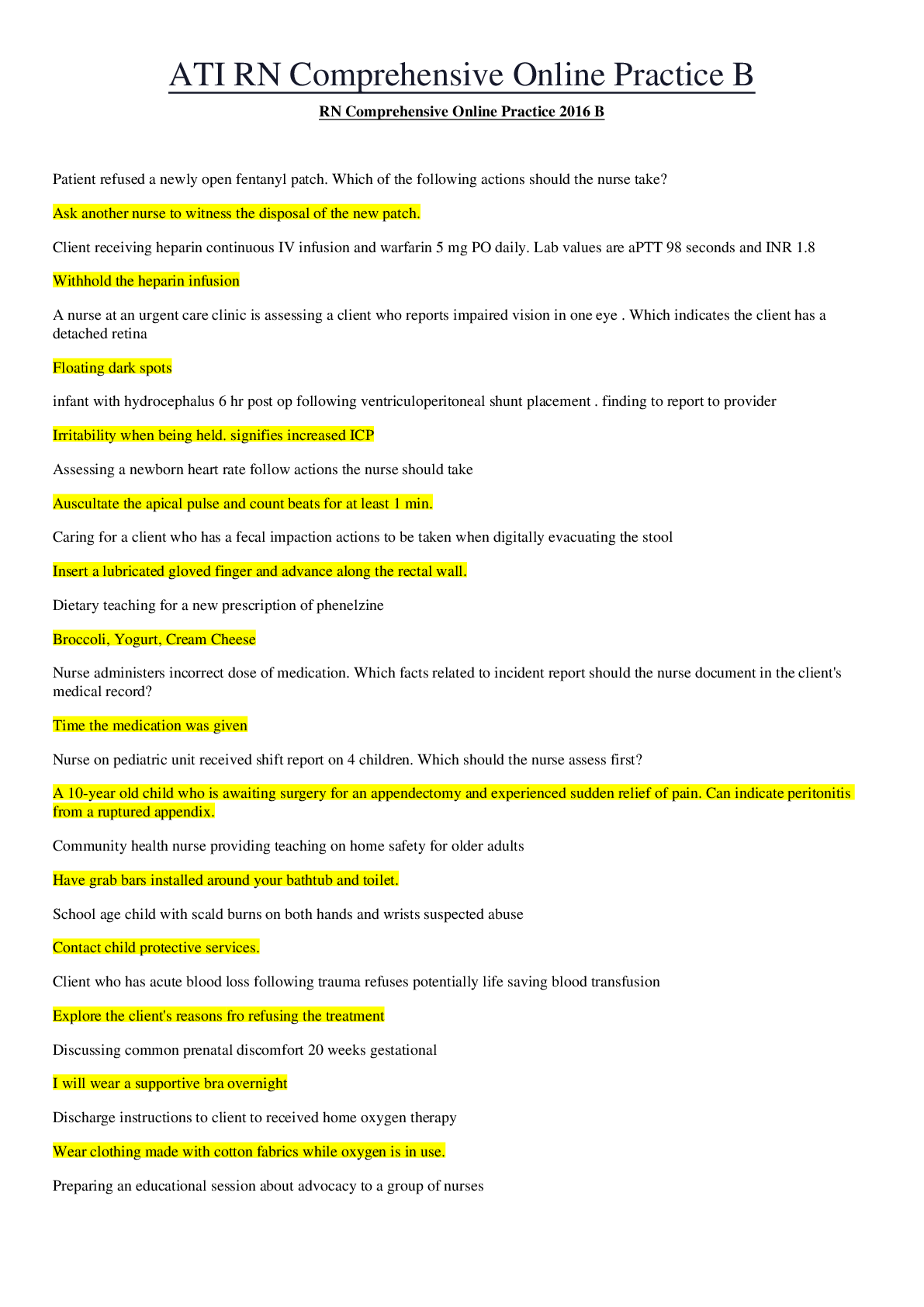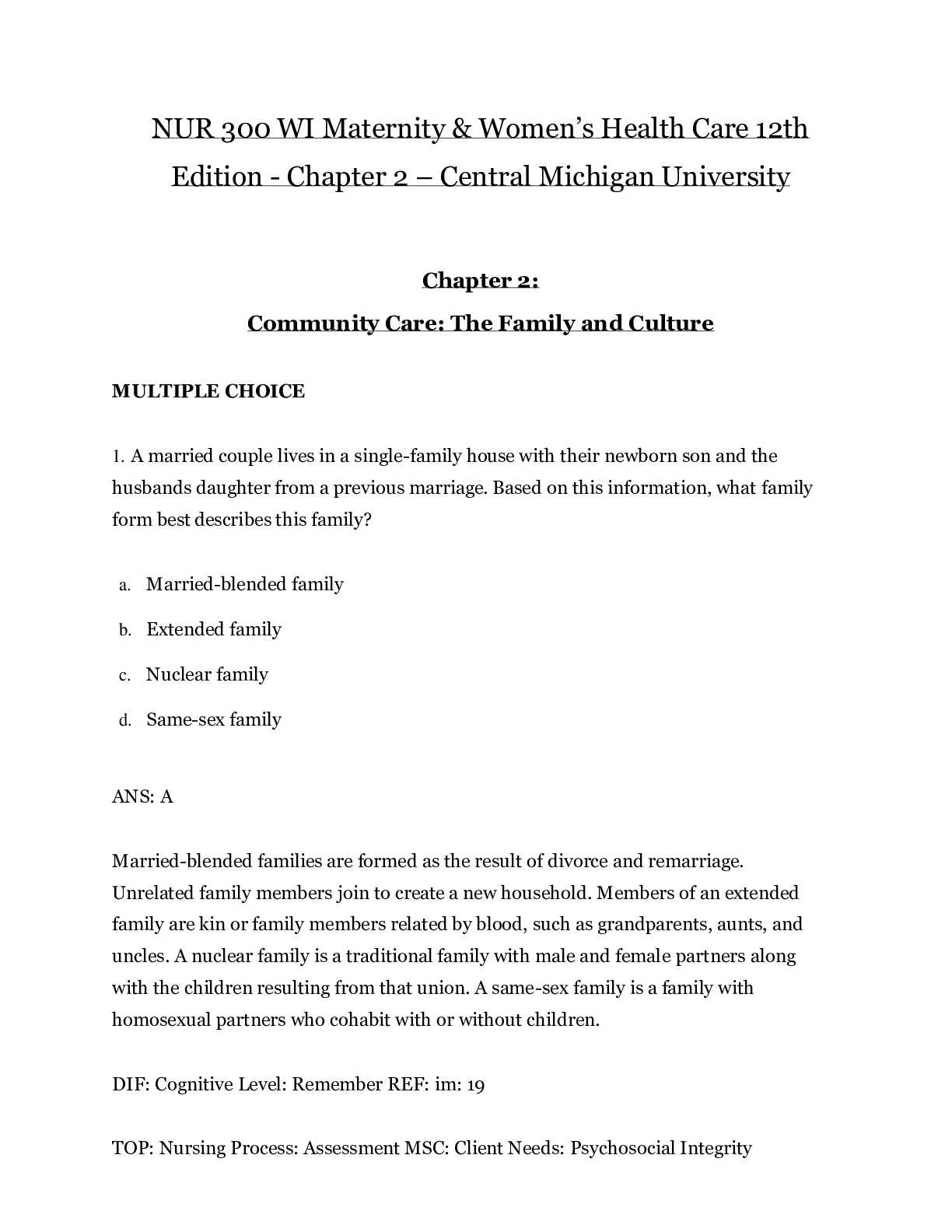*NURSING > EXAM > NUR 300 WI Maternity & Women’s Health Care 12th Edition (2019/2020) - Chapter 13 – Central Michi (All)
NUR 300 WI Maternity & Women’s Health Care 12th Edition (2019/2020) - Chapter 13 – Central Michigan University | Anatomy and Physiology of Pregnancy
Document Content and Description Below
NUR 300 WI Maternity & Women’s Health Care 12th Edition - Chapter 13 – Central Michigan University Chapter 13: Anatomy and Physiology of Pregnancy MULTIPLE CHOICE 1. A womans obstetric ... history indicates that she is pregnant for the fourth time, and all of her children from previous pregnancies are living. One was born at 39 weeks of gestation, twins were born at 34 weeks of gestation, and another child was born at 35 weeks of gestation. What is her gravidity and parity using the GTPAL system? a. 3-1-1-1-3 b. 4-1-2-0-4 c. 3-0-3-0-3 d. 4-2-1-0-3 Using the GTPAL system, 4-1-2-0-4 is the correct calculation of this womans gravidity and parity. The numbers reflect the womans gravidity and parity information. Her information is calculated as: G reflects the total number of times the woman has been pregnant; she is pregnant for the fourth time. T indicates the number of pregnancies carried to term, not the number of deliveries at term; only one of her pregnancies resulted in a fetus at term. P is the number of pregnancies that resulted in a preterm birth; the woman has had two pregnancies in which she delivered preterm. A signifies whether the woman has had any abortions or miscarriages before the period of viability; she has not. L signifies the number of children born who are currently living; the woman has four children. 3-1-1-1-3 is an incorrect calculation of this womans gravidity and parity; 3-0-3-0-3 is an incorrect calculation of this womans gravidity and parity; and 4-2-1-0-3 is an incorrect calculation of this womans gravidity and parity. DIF: Cognitive Level: Understand REF: IMS: 284 TOP: Nursing Process: Diagnosis MSC: Client Needs: Health Promotion and Maintenance 2. Which presumptive sign or symptom of pregnancy would a client experience who is approximately 10 weeks of gestation? a. Amenorrhea b. Positive pregnancy test c. Chadwick sign d. Hegar sign Amenorrhea is a presumptive sign of pregnancy. Presumptive signs of pregnancy are those felt by the woman. A positive pregnancy test and the presence of the Chadwick and Hegar signs are all probable signs of pregnancy. DIF: Cognitive Level: Understand REF: IMS: 285 TOP: Nursing Process: Assessment MSC: Client Needs: Health Promotion and Maintenance 3. A client is seen at the clinic at 14 weeks of gestation for a follow-up appointment. At which level does the nurse expect to palpate the fundus? a. Nonpalpable above the symphysis at 14 weeks of gestation b. Slightly above the symphysis pubis c. At the level of the umbilicus d. Slightly above the umbilicus In normal pregnancies, the uterus grows at a predictable rate. It may be palpated above the symphysis pubis sometime between the 12th and 14th weeks of pregnancy. As the uterus grows, it may be palpated above the symphysis pubis sometime between the 12th and 14th weeks of pregnancy. At 14 weeks, the uterus is not yet at the level of the umbilicus. The fundus is not palpable above the umbilicus until 22 to 24 weeks of gestation. DIF: Cognitive Level: Apply REF: IMS: 286 TOP: Nursing Process: Assessment MSC: Client Needs: Health Promotion and Maintenance 4. The musculoskeletal system adapts to the changes that occur throughout the pregnancy. Which musculoskeletal alteration should the client expect? a. Her center of gravity will shift backward. b. She will have increased lordosis. c. She will have increased abdominal muscle tone. d. She will notice decreased mobility of her pelvic joints. An increase in the normal lumbosacral curve (lordosis) develops, and a compensatory curvature in the cervicodorsal region develops to help her maintain balance. The center of gravity shifts forward. She will have decreased abdominal muscle tone and will notice increased mobility of her pelvic joints. DIF: Cognitive Level: Understand REF: IMS: 296 TOP: Nursing Process: Planning MSC: Client Needs: Physiologic Integrity 5. A 31-year-old woman believes that she may be pregnant. She took an over-the-counter (OTC) pregnancy test 1 week ago after missing her period; the test was positive. During her assessment interview, the nurse inquires about the womans last menstrual period and asks whether she is taking any medications. The client states that she takes medicine for epilepsy. She has been under considerable stress lately at work and has not been sleeping well. Her physical examination does not indicate that she is pregnant. She has an ultrasound scan, which confirms that she is not pregnant. What is the most likely cause of the false-positive pregnancy test result? a. The pregnancy test was taken too early. b. Anticonvulsant medications may cause the false-positive test result. c. The woman has a fibroid tumor. d. She has been under considerable stress and has a hormone imbalance. Anticonvulsants may cause false-positive pregnancy test results. OTC pregnancy tests use enzyme-linked immunosorbent assay (ELISA) technology, which can yield positive results as soon as 4 days after implantation. Implantation occurs 6 to 10 days after conception. If the woman were pregnant, then she would be into her third week at this point (having missed her period 1 week ago). Fibroid tumors do not produce hormones and have no bearing on human chorionic gonadotropin (hCG) pregnancy tests. Although stress may interrupt normal hormone cycles (menstrual cycles), it does not affect hCG levels or produce positive pregnancy test results. DIF: Cognitive Level: Apply REF: IMS: 285 TOP: Nursing Process: Assessment MSC: Client Needs: Physiologic Integrity 6. A woman is in her seventh month of pregnancy. She has been complaining of nasal congestion and occasional epistaxis. Which statement best describes why this may be happening to this client? a. This respiratory change is normal in pregnancy and caused by an elevated level of estrogen. b. This cardiovascular change is abnormal, and the nosebleeds are an ominous sign. c. The woman is a victim of domestic violence and is being hit in the face by her partner. d. The woman has been intranasally using cocaine. Elevated levels of estrogen cause capillaries to become engorged in the respiratory tract, which may result in edema in the nose, larynx, trachea, and bronchi. This congestion may cause nasal stuffiness and epistaxis. Cardiovascular changes in pregnancy may cause edema in the lower extremities. Domestic violence cannot be determined on the basis on the sparse facts provided. If the woman had been hit in the face, then she most likely would have additional physical findings. Cocaine use cannot be determined on the basis on the sparse facts provided. DIF: Cognitive Level: Apply REF: IMS: 294 TOP: Nursing Process: Assessment MSC: Client Needs: Health Promotion and Maintenance 7. The nurse is providing education to a client regarding the normal changes of the breasts during pregnancy. Which statement regarding these changes is correct? a. The visibility of blood vessels that form an intertwining blue network indicates full function of the Montgomery tubercles and possibly an infection of the tubercles. b. The mammary glands do not develop until 2 weeks before labor. c. Lactation is inhibited until the estrogen level declines after birth. d. Colostrum is the yellowish oily substance used to lubricate the nipples for breastfeeding. Lactation is inhibited until after birth. The visible blue network of blood vessels is a normal outgrowth of a richer blood supply. The mammary glands are functionally complete by midpregnancy. Colostrum is a creamy white-to-yellow premilk fluid that can be expressed from the nipples before birth. DIF: Cognitive Level: Understand REF: IMS: 290 TOP: Nursing Process: Planning MSC: Client Needs: Health Promotion and Maintenance 8. Which hormone is essential for maintaining pregnancy? a. Estrogen b. hCG c. Oxytocin d. Progesterone Progesterone is essential for maintaining pregnancy; it does so by relaxing smooth muscles, which reduces uterine activity and prevents miscarriage. Estrogen plays a vital role in pregnancy, but it is not the primary hormone for maintaining pregnancy. hCG levels rise at implantation but decline after 60 to 70 days. Oxytocin stimulates uterine contractions. DIF: Cognitive Level: Remember REF: IMS: 299 TOP: Nursing Process: Assessment MSC: Client Needs: Health Promotion and Maintenance 9. Which clinical finding in a primiparous client at 32 weeks of gestation might be an indication of anemia? a. Ptyalism b. Pyrosis c. Pica d. Decreased peristalsis Pica (a desire to eat nonfood substances) is an indication of iron deficiency and should be evaluated. Cravings include ice, clay, and laundry starch. Ptyalism (excessive salivation), pyrosis (heartburn), and decreased peristalsis are normal findings. DIF: Cognitive Level: Analyze REF: IMS: 298 TOP: Nursing Process: Assessment MSC: Client Needs: Health Promotion and Maintenance 10. Why might it be more difficult to diagnose appendicitis during pregnancy? a. The appendix is displaced upward and laterally, high and to the right. b. The appendix is displaced upward and laterally, high and to the left. c. The appendix is deep at the McBurneys point. d. The appendix is displaced downward and laterally, low and to the right. The appendix is displaced high and to the right, not to the left. It is displaced beyond the McBurneys point and is not displaced in a downward direction. DIF: Cognitive Level: Understand REF: IMS: 298 TOP: Nursing Process: Diagnosis MSC: Client Needs: Physiologic Integrity 11. The nurse is providing health education to a pregnant client regarding the cardiovascular system. Which information is correct and important to share? a. A pregnant woman experiencing disturbed cardiac rhythm, such as sinus arrhythmia, requires close medical and obstetric observation no matter how healthy she may appear otherwise. b. Changes in heart size and position and increases in blood volume create auditory changes from 20 weeks of gestation to term. c. Palpitations are twice as likely to occur in twin gestations. d. All of the above changes will likely occur. These auscultatory changes should be discernible after 20 weeks of gestation. A healthy woman with no underlying heart disease does not need any therapy. The maternal heart rate increases in the third trimester, but palpitations may not necessarily occur, let alone double. Auditory changes are discernible at 20 weeks of gestation. DIF: Cognitive Level: Understand REF: IMS: 290 TOP: Nursing Process: Planning MSC: Client Needs: Physiologic Integrity - - - - - - - - - - - - - - - - - - - 25. To reassure and educate their pregnant clients regarding changes in their blood pressure, nurses should be cognizant of what? a. A blood pressure cuff that is too small produces a reading that is too low; a cuff that is too large produces a reading that is too high. b. Shifting the clients position and changing from arm to arm for different measurements produces the most accurate composite blood pressure reading at each visit. c. Systolic blood pressure slightly increases as the pregnancy advances; diastolic pressure remains constant. d. Compression of the iliac veins and inferior vena cava by the uterus contributes to hemorrhoids in the later stage of a term pregnancy. Compression of the iliac veins and inferior vena cava by the uterus contributes to hemorrhoids in the later stage of a term pregnancy. This compression also leads to varicose veins in the legs and vulva. The tightness of a blood pressure cuff that is too small produces a reading that is too high; similarly, the looseness of a cuff that is too large results in a reading that is too low. Because maternal positioning affects readings, blood pressure measurements should be obtained in the same arm and with the woman in the same position. The systolic blood pressure generally remains constant but may decline slightly as the pregnancy advances. The diastolic blood pressure first decreases and then gradually increases. DIF: Cognitive Level: Understand REF: IMS: 292 TOP: Nursing Process: Planning | Nursing Process: Implementation MSC: Client Needs: Physiologic Integrity 26. Which finding in the urinalysis of a pregnant woman is considered a variation of normal? a. Proteinuria b. Glycosuria c. Bacteria in the urine d. Ketones in the urine Small amounts of glucose may indicate physiologic spilling. The presence of protein could indicate kidney disease or preeclampsia. Urinary tract infections are associated with bacteria in the urine. An increase in ketones indicates that the patient is exercising too strenuously or has an inadequate fluid and food intake. DIF: Cognitive Level: Analyze REF: IMS: 295 TOP: Nursing Process: Assessment MSC: Client Needs: Physiologic Integrity 27. Cardiac output increases from 30% to 50% by the 32nd week of pregnancy. What is the rationale for this change? a. To compensate for the decreased renal plasma flow b. To provide adequate perfusion of the placenta c. To eliminate metabolic wastes of the mother d. To prevent maternal and fetal dehydration The primary function of increased vascular volume is to transport oxygen and nutrients to the fetus via the placenta. Renal plasma flow increases during pregnancy. Assisting with pulling metabolic wastes from the fetus for maternal excretion is one purpose of the increased vascular volume. DIF: Cognitive Level: Understand REF: IMS: 287 TOP: Nursing Process: Assessment MSC: Client Needs: Physiologic Integrity 28. Which statement best describes the rationale for the physiologic anemia that occurs during pregnancy? a. Physiologic anemia involves an inadequate intake of iron. b. Dilution of hemoglobin concentration occurs in pregnancy with physiologic anemia. c. Fetus establishes the iron stores. d. Decreased production of erythrocytes occur. When blood volume expansion is more pronounced and occurs earlier than the increase in red blood cells, the woman has physiologic anemia, which is the result of the dilution of hemoglobin concentration rather than inadequate hemoglobin. An inadequate intake of iron may lead to true anemia. The production of erythrocytes increases during pregnancy. DIF: Cognitive Level: Remember REF: IMS: 292 TOP: Nursing Process: Assessment MSC: Client Needs: Physiologic Integrity 29. A patient in her first trimester complains of nausea and vomiting. She asks, Why does this happen? What is the nurses best response? a. Nausea and vomiting are due to an increase in gastric motility. b. Nausea and vomiting may be due to changes in hormones. c. Nausea and vomiting are related to an increase in glucose levels. d. Nausea and vomiting are caused by a decrease in gastric secretions. Nausea and vomiting are believed to be caused by increased levels of hormones, decreased gastric motility, and hypoglycemia. Gastric motility decreases during pregnancy. Glucose levels decrease in the first trimester. Although gastric secretions decrease, these secretions are not the primary cause of the nausea and vomiting. DIF: Cognitive Level: Understand REF: IMS: 297 TOP: Nursing Process: Implementation MSC: Client Needs: Physiologic Integrity [Show More]
Last updated: 2 years ago
Preview 1 out of 34 pages

Buy this document to get the full access instantly
Instant Download Access after purchase
Buy NowInstant download
We Accept:

Reviews( 0 )
$12.50
Can't find what you want? Try our AI powered Search
Document information
Connected school, study & course
About the document
Uploaded On
Jun 28, 2020
Number of pages
34
Written in
Additional information
This document has been written for:
Uploaded
Jun 28, 2020
Downloads
0
Views
88








 – University of the People.png)

















